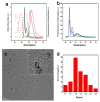Ratiometric pH Sensing and Imaging in Living Cells with Dual-Emission Semiconductor Polymer Dots
- PMID: 31409040
- PMCID: PMC6721214
- DOI: 10.3390/molecules24162923
Ratiometric pH Sensing and Imaging in Living Cells with Dual-Emission Semiconductor Polymer Dots
Abstract
Polymer dots (Pdots) represent newly developed semiconductor polymer nanoparticles and exhibit excellent characteristics as fluorescent probes. To improve the sensitivity and biocompatibility of Pdots ratiometric pH biosensors, we synthesized 3 types of water-soluble Pdots: Pdots-PF, Pdots-PP, and Pdots-PPF by different combinations of fluorescent dyes poly(9,9-dioctylfluorenyl-2,7-diyl) (PFO), poly[(9,9-dioctyl-fluorenyl-2,7-diyl)-co-(1,4-benzo-{2,1',3}-thiadazole)] (PFBT), and fluorescein isothiocyanate (FITC). We found that Pdots-PPF exhibits optimal performance on pH sensing. PFO and FITC in Pdots-PPF produce pH-insensitive (λ = 439 nm) and pH-sensitive (λ = 517 nm) fluorescence respectively upon a single excitation at 380 nm wavelength, which enables Pdots-PPF ratiometric pH sensing ability. Förster resonance energy transfer (FRET) together with the use of PFBT amplify the FITC signal, which enables Pdots-PPF robust sensitivity to pH. The emission intensity ratio (I517/I439) of Pdots-PPF changes linearly as a function of pH within the range of pH 3.0 to 8.0. Pdots-PPF also possesses desirable reversibility and stability in pH measurement. More importantly, Pdots-PPF was successfully used for cell imaging in Hela cells, exhibiting effective cellular uptake and low cytotoxicity. Our study suggests the promising potential of Pdots-PPF as an in vivo biomarker.
Keywords: FRET; Pdots; cell imaging; pH sensing; semiconductor polymer.
Conflict of interest statement
The authors have no conflicts of interest to declare.
Figures








References
-
- Näreoja T., Deguchi T., Christ S., Peltomaa R., Prabhakar N., Fazeli E., Perälä N., Rosenholm J.M., Arppe R., Soukka T. Ratiometric sensing and imaging of intracellular pH using polyethylenimine-coated photon upconversion nanoprobes. Anal. Chem. 2017;89:1501–1508. doi: 10.1021/acs.analchem.6b03223. - DOI - PubMed
-
- Consolati T., Bolivar J.M., Petrasek Z., Berenguer J., Hidalgo A., Guisaán J.M., Nidetzky B. Biobased, Internally pH-Sensitive Materials: Immobilized Yellow Fluorescent Protein as an Optical Sensor for Spatiotemporal Mapping of pH Inside Porous Matrices. ACS Appl. Mater. Interfaces. 2018;10:6858–6868. - PubMed
MeSH terms
Substances
Grants and funding
LinkOut - more resources
Full Text Sources
Other Literature Sources
Miscellaneous

